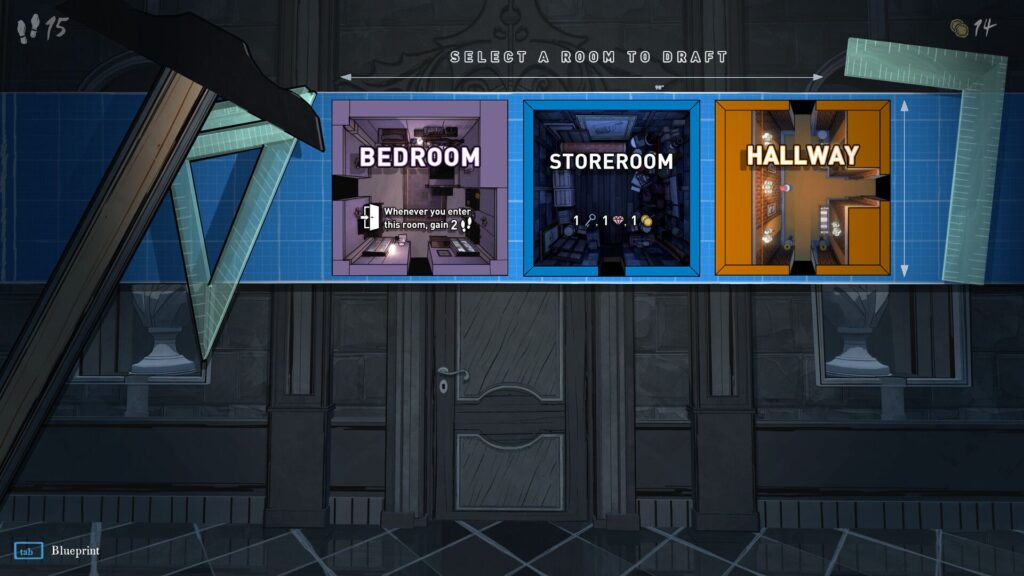There have been plenty of puzzle games released over the years that have had fundamental effects on how gaming is seen by many, ranging from 2016’s The Witness to 2018’s Return of the Obra Dinn. History will likely have a similar view of Dogubomb’s puzzle game – Blue Prince – which is especially interesting because of how it marries together its core puzzle-based gameplay with a roguelike structure.
The core premise behind Blue Prince is that you, as protagonist Simon P. Jones, are the heir to the estate left behind by Baron Herbert S. Sinclair. Inheriting his 45-room estate, however, comes with one big condition; Jones must explore the mansion and find a secret 46th room in the estate. To achieve this, there are a few more rules. Jones can’t bring in any outside objects, and he can’t spend a night in the estate. Oh, and the randomised layout of the Sinclair estate resets every morning. Armed with this knowledge, Jones has to set out on excursions into the estate in his attempts to get closer to the Antechamber, which in turn will lead him to further parts of the mansion, including the secret Room 46.
“Not all rooms are created equal, and one of the most important aspects of picking which room to be next is what layout you want.”
While the core narrative might seem quite simple, tapping into the classic trope of “spend some time in this mansion to inherit it” that we’ve seen in several stories before, Blue Prince doesn’t simply leave its storytelling to the opening cutscene. Rather, there are plenty of hints and clues about deeper secrets that the Sinclair estate might be hiding, largely left behind through journal entries, written letters, computer logs, and even the existence and state of certain rooms.
Gameplay is one of the areas where Blue Prince manages to get a lot out of little. The controls are fairly simple; you have movement, interactions, and backing out of them, and that’s about it. There is no jumping or crouching here, and the entire game essentially revolves around you walking around, exploring the various rooms of the mansion, interacting with switches or levers, and occasionally reading some notes that were left behind by previous visitors. There is also no combat system in the game, and there aren’t even any threats – aside from your own mistakes – that might cause your run to come to a premature end.
As for the general game structure, you get to explore the Sinclair estate on a room-by-room basis, and once you’re ready to move on, you interact with a door that then gives you three options to choose from for what the next room will be. This is where one of the core puzzle-solving aspects of Blue Prince starts coming into focus. Not all rooms are created equal, and one of the most important aspects of picking which room to be next is what layout you want. While the first room of the estate will always have three doors to choose from, other rooms won’t give you as many options. You also have to balance your desire to have rooms in the right direction with whether you need certain items, like keys, gems or coins, which can then be used up in other rooms.

“Not all rooms are created equal, and one of the most important aspects of picking which room to be next is what layout you want.”
Quite a few of the rooms also tend to have their own unique puzzles associated with them. For example, you will be able to find a Security Room quite early in the game, which can give you quite a few hints just by examining the nearby notice board. There’s also a computer, which in turn can give you further hints as well as control over things like how keycard readers might work. The Billiards room, on the other hand, has a math-based puzzle that can reward you with some extra goodies, while the Parlor room has a classic three-box puzzle that tasks you with figuring out which of the boxes has the reward.
Early runs of Blue Prince have a tendency to fail because you’re often still trying to get your bearings and figure things out, and it can be incredibly easy to accidentally create a dead end for yourself with no new doors left to open. This is one of the two failure states possible in the game, the other being you running out of the equivalent of health – steps – which you start each run with 50 of and lose 1 for every room you enter. Aside from these failure states, the fact that there is really no other way to fail means that you are encouraged to experiment quite a bit, be it with testing out what brand new rooms do, or even checking out the outer grounds of the mansion, which tend to hide their own secrets.
There is also a loose progression system in Blue Prince which revolves around you upgrading rooms by finding the appropriate disc in them. These discs can then be used at a security terminal to upgrade a room to offer, for example, more items or even greater healing items to help you recover steps. There is also a meta progression system that revolves around discovering stars through an observatory room, through which different constellations can be observed that then grant boons or curses on your run. None of these progression systems are strictly necessary to play through Blue Prince, however, since your success in the game largely comes down to how well you’re able to lay down rooms and how well you can solve its various puzzles.

“It can be incredibly easy to accidentally create a dead end for yourself with no new doors left to open.”
Blue Prince is an incredibly unique game in how it’s able to tie together its approach to puzzle solving and its overall roguelike game structure. You never really feel like you’ve wasted a run on meaningless room choices because you’re constantly learning something new. For example, the fateful run where you finally get to the Antechamber will then lead you to an entirely new set of puzzles, each of which requires its own special rooms that you’re going to have to find. Similarly, there is also a fair bit of environmental storytelling that can be gleaned from the letters left behind as well as just the kinds of rooms that Herbert S. Sinclair had in his mansion. In fact, there are so many little notes that you can find all over the place that even the game itself recommends that you should keep a handwritten notebook nearby while playing.
The presentation also goes a long way in making Blue Prince an absolute joy to play. The title goes for a fairy tale look with thick outlines, excellent use of lighting and sharp contrasts in its use of colours. This makes finding objects that can be interacted with simple, while also not leaving behind any detail might further help with its worldbuilding and storytelling. A nice little detail of the presentation is that, at the end of the run, you get a look at what the manor you ultimately designed would look like with a rough sketch, depending on the rooms you picked and where you placed them. Focus on exploring the western side of the estate and you will inevitably end up with a west-facing manor. Similarly, putting down an observatory will also mean you see the dome of this observatory in the end-of-run screen.

“The presentation also goes a long way in making Blue Prince an absolute joy to play.”
The added benefit of this art style is that it doesn’t require a hefty system to run; my PC with an AMD Ryzen 7 7800X3D, 32 GB of DDR5-6000 RAM and an AMD Radeon RX 7800 XT had no troubles with keeping up high frame rates throughout my time with the game, while playing at a resolution of 2560 x 1440.
The audio, on the other hand, has been designed around the central idea of staying out of the way. The game features some faint music in the background, but that just adds to the overall inquisitive atmosphere that it is trying to foster without creating much of a disturbance for you while you’re thinking about a puzzle, for example. The voice acting, as little of it as there is, is also quite great, with Sinclair in particular being voiced quite well in his posthumous letter that kicks off the events of Blue Prince.
The unique take that Blue Prince offers on the puzzle and roguelike genres essentially stands on its own; there has simply never really been a game like it. The fact that its various puzzles don’t happen to be the kind that will have you start tearing your hair out also makes it an incredibly easy title to recommend even to those that might not really have too many puzzle games before.
This game was reviewed on PC.



